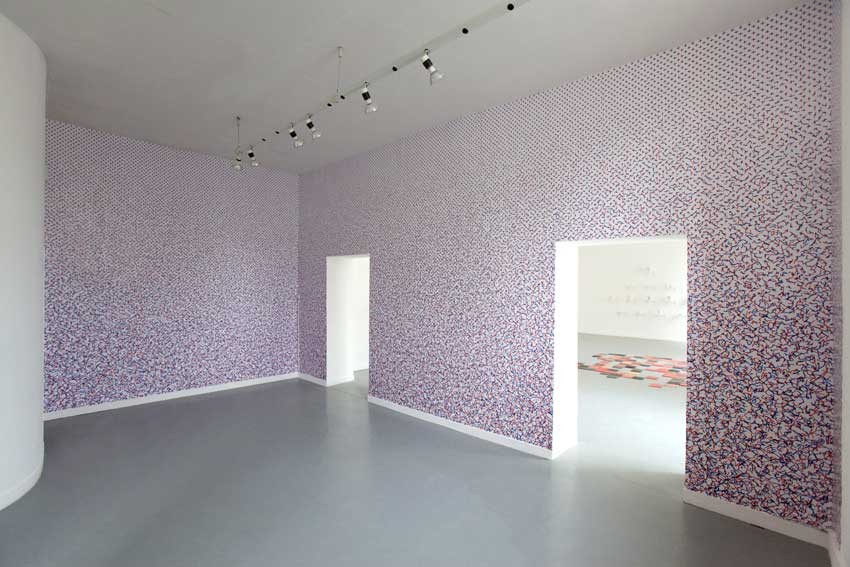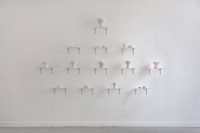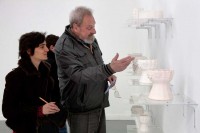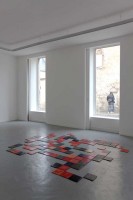Que la pureté n’existe pas, c’est une évidence ou une manière de voir les choses. Pureté de l’original, pureté de l’identité, pureté de l’unicité du discours, pureté de l’humain dirigeant les machines. En quoi croire et comment s’organiser pour créer un « monde » qui s’accorde à nos désirs ? Le Hacker grail est une pièce à la fois documentaire et fictionnelle, dont l’intérêt réside d’une part dans sa matérialisation, d’autre part dans la convivialité qui l’entoure et l’a rendue possible. Il n’a pas été suffisant d’imprimer un unique exemplaire du graal : il s’agit bel et bien d’une série d’objets, tous uniques, mais chacun généré par le même fichier digital. Cette série a été causée par des rencontres : des alliances entre des institutions, mais surtout des personnes et des savoir-faire distincts et spécialisés. La convivialité nécessaire est donc avant tout une curiosité partagée.
Â
The Hacker Grail
by Donatella Bernardi and Charlie Stern
Exhibition Time vs Machine in La Box, Bourges (organized by Fabienne Bideaud, curator, and Ann Guillaume, artist, April 4th-24th 2013) and codex by Boabooks
 Blue Cross and Red Spaghetti, 2013, in collaboration with Niels Wehrspann. Photo: Jean Frémiot.
Blue Cross and Red Spaghetti, 2013, in collaboration with Niels Wehrspann. Photo: Jean Frémiot.
A machine?
– Just what kind of machine is this?
A machine like the war machine in the Treatise on Nomadology (Gilles Deleuze and Félix Guattari, Capitalisme et schizophrénie 2, Mille plateaux), the war machine as the functional model for a horde, a collective, a multiplicity. The leader is the sorcerer: the craziest, out of the ordinary one who is always in the margin, the one who anticipates, who observes and lets things fall as they may until a witch takes the reins. She will then be burned before a cathedral or on a public square because she proceeds to ally reason with instinct; and in the Church, in institutions, only men with books will be represented, the sword and the chalice filled with wine – the Blood of the Savior inebriates to the point of death. But the wheels turn and the machine advances even though sometimes, “they don’t lose each other, they don’t love each other”, a bit like in courtly love. Today, it would be the machine of self-organization rather than of revolution (Dmitry Kleiner, Telekommunist Manifesto) whisper the adepts of a technology of sharing, of decentralization. Today, there is a promise of the democracy of data, an ideal pursue by some, occasionally through hacking. “What is yours is mine, and what is mine is yours”, declares a member of Piratbyrån and Sparvnästet. Really? If I agree to be your object, will you let me be my subject? Is that even possible? Who sees (can see) what during “gendered” love? What do biology and anatomical mechanics dictate? The machine is also the machine of desire, or rather, the desire which is the powerful machine that produces reality, teaches us “anti-psychoanalysis”, and goes beyond “familiarism” or the bourgeois order, and the daddy-mommy construct (Gilles Deleuze and Félix Guattari, Capitalisme et schizophrénie 1, L’anti-Œdipe). Is the desire that governs a group of Jesuits, a masculine community, the same as the desire that drives the unisex collective of an art school born of the rapprochement between fine art, architecture and military science, as in the case of the current National Graduate School of Art in Bourges? These collectives have inhabited the same historic walls and archeological strata daily since the 17th century. No doubt there are vestiges and nodes: the elite reproduce beyond guillotines, gas chambers and the desaparecidos. Indeed, even after the most massive, organized and collective crimes or revolutions, organized societies cannot so easily get rid of their infrastructure or power management forces. To turn one’s coat. Reformation. Restructuration. In Bourges, the French Revolution did not bring about the destruction of this solid religious architecture, only to build it anew. On the contrary, the Enlightenment spirit was established in the former monastery: the Encyclopedists’ work of classification that is intellectual, and, here, also spatial and productive of savoir-faire, is truly tangible. You might say it is an instance of fossilization, sedimentation or palimpsest dynamics which is at stake in many institutional evolutions. The German artist Clemens von Wedemeyer created his film Muster (Rushes), 2012, around these notions. His work has as its starting point Breitenau, Kassel, where a former Benedictine monastery was first converted into a prison and then into a concentration and work camp before becoming a girl’s reform school and, finally, an open psychiatric clinic. And that’s for the state apparatus and its institutions. What of the war machine and its horde? A genealogy and mutation of the ones who rule and the ones who counter-rule. Transmission. Are you one of the elected, one of the powerful? Are you going to shift, to drift? If not you, maybe your children, disciples, apostles or even alumni? If one comes to better master your setting, resources and technology, does one really betray you? Does anyone own God? Is it not beautiful when your system is actually upgraded by others? The most talented often becomes the strongest dissident, first out of sheer boredom and a longing for excitement, adventure, challenge, most of the time in haste. Pirates and hackers might be the most subverted cognitive capitalists. And Satan was the favorite angel. Some consider that Judas merely obeyed Christ, who asked him for betrayal. Indeed, Christ needed to be arrested, condemned and killed to make the story more dramatic, bloody and to save humankind. How many pictures and Hollywood products have been made possible through this traitorous kiss? Passion is needed in any narrative, and it has nothing to do with morality. “At the centre of my ironic faith, my blasphemy, is the image of the cyborg”, writes Donna Haraway in her essay Cyborg Manifesto.
Sparvnästet
Starting in October 2012 and continuing until March 2013, the hacker space Sparvnästet, founded in Stockholm in 2010, is being hosted at the Royal Institute of Art on the Skeppsholmen Island. The group is made up of people that meet like children coming together to play without supervision. Since they are all adults and employees, the playground follows a regular workday schedule: Tuesday, 6pm, until late.
“Sparvnästet”: what kind of name is that ? If you pronounce it quickly, it might sound like “spider nest”. Literally translated from Swedish, it means “sparrow’s nest”. An online discussion took place about this latter point among the sparrows. To exchange ideas on the Internet is like sharing a common dialogue that won’t be disturbed by time or psychology, unlike talking on the phone, Voice over Internet Protocol or in person. Indeed, your interlocutor expects a direct answer from you, a sign that you are listening with careful attention, a sound or a look that confirms your (good willing) present availability towards him or her. Online and through emails, communication rhythms might be fast, slow, interrupted and resumed, perhaps similarly to when your interlocutors are suddenly in front of you, or walking besides you for a bit. What then is orality’s status when confronting written language? Does online correspondence create a new literary format, increasingly allowing one to go beyond truth and falsity for the sake of pleasure, fantasy and mythology? “Sparvnästet” had been crystallized in the context of the social center Hemliga trädgården “secret garden”, Midsommarkransen, Stockholm, where many different groups gathered, like a great antler, the “sparrow’s nest” being one of the appendages. “Sparvnästet” mirrors lawyer Monique Wadsted defending industries’ interests during the first Pirate Bay trial in 2009: “piracy is like lying on your back, letting fried sparrows fly into your mouth, no matter whether you are hungry or not. The sparrows also lie around you in droves, for you to consume anytime you like, without any kind of sacrifice on your behalf being required. Of course a certain feeling of satiety arises.” Sparvnästet is thus a refuge that allows an abundance of information and more. Cockaigne has found its place. Actually, Sparrow is a famous Walt Disney pirate, Captain Jack Sparrow, and his nest is a safe haven for piracy. Sparvnästet is a provocative play on words with a Swedish saying: “Det kommer inte komma några stekta sparvar flygande”, “There will be no fried sparrows flying”, metaphor for the moralistic statement that nothing in life is free. In 2002, the Swedish king Carl XVI Gustaf mentioned the sparrow saying in his Christmas allocution: “Det kommer inga stekta sparvar flygande om Du inte själv bemödar Dig om att göra Ditt bästa”, “There will be no fried sparrow flying unless you don't surely endeavor to do your best”. The first iteration of Sparvnästet appeared in Myra’s apartment, a few years before the Pirate Bay trial. These small, harmless animals were welcomed in a nest that was also a bastion. Sparrows migrate every year from Sweden to North Africa. They are nomadic, moving freely in a smooth space, in opposition to the stratified space where the state apparatus is located (Gilles Deleuze and Félix Guattari, Capitalisme et schizophrénie 2, Mille plateaux). In fact, Sparvnästet is a secret organization from the 18th century, and was initially a robotic society from the 15th Century.
Skeppsholmen, 6pm in Stockholm between October and February means total night, sometimes rain, mainly snow and ice, mostly cold and wind, and at least, fresh air. Therefore, Sparvnästet happens in the middle of a Nordic darkness in what is called “hus 28”, a little house independent from the main building of the Royal Institute of Art, directly by the waterside. The people that gather here on the central Skeppsholmen Island (a former naval base for four centuries) rarely give their name. They come and go without restraint. Anonymity is therefore compatible with physical encounters, embodiment and the geo-localization of a moving, unstable and changing multiplicity, achieving freedom because it is loose and spontaneous. Skeppsholmen Island itself is a highly strategic point at the core of the Scandinavian city, and yet remote since it is accessible only by bridge and boat. The isle is perhaps deeply romantic and picturesque thanks to the water and the surrounding historical buildings that provide a grandiose, nostalgic, unchangeable and outdated panorama that crystallizes itself into a sublime and tangible urban marina. In the case of Sparvnästet, on the contrary, new faces pop up each time, and the frequent attendees quickly become temporary regulars. Composed almost exclusively by young white Swedish males, it is all but impossible to conclude that a sexual or ethnic identity emerges from this human conglomerate, since the individual laptops displayed on a large common table, along with other gadgets and electronic devices scattered in the space, function simultaneously as strong mediators, centers of interest and attention, objects, props, toys, recipients, tools, media players, interfaces, screens, mirrors and windows to oneself and the world – which includes the Internet. Indeed, among Pirate Bay makers and followers, AFK, or “away from keyboard”, is used instead of IRL, “in real life”, because computer work is real life. Much more than being questionable (and objectionable?) regarding its gender specificity, Sparvnästet is, possibly, more like a cyborg, “a cybernetic organism, a hybrid of machine and organism, a creature of social reality as well as a creature of fiction. Social reality is lived social relations, our most important social construction, a world-changing fiction.” (Donna Haraway, A Cyborg Manifesto).
Sparvnästet has been experimenting 3D scanning and printing techniques in some of its meetings. What is happening nowadays within the field of objects’ conception, production and reproduction probably equals the image’s revolutionary transformation when photography and, later, film appeared. In this context, how will patent and copyright issues, and the massive commercialization of 3D scanners and printers evolve? Will your life be changed by the fact that you can print objects with the help of domestic and affordable machines? Are you going to be more of a doer, a maker, a designer, an entrepreneur, a manager of your tridimensional environment, an infinite and emancipated creative person since you have already digitally photographed and filmed so much that you are lacking terabyte storage? Can you escape consumerism by being a producer or a craftsman/woman using digital technology? Democratization processes are far more complex than just having access to mechanical reproduction techniques or online blogs. In this essay’s framework, let’s say that through 3D scanning and printing techniques, origin and rarity are challenged once more thanks to the industrially “made” and yet “unique” – a “bug-induced uniqueness”, that is.
“Hacker Grail" ready to bug
The Hacker Grail addresses issues such as community, belief, anonymity, shared values and mysticism. The fabrication of an object, a version of the Holy Grail whose original is unknown and uncertain, will be carried out through 3D scanning and 3D clay printing. More than just gems, the ornament of the Hacker Grail will feature a common and anonymous self-portrait. How would that be possible? The idea is to quote and expand the concept of Janus, the Roman god of gateways, doors and access. Linked with time, its antique representation traditionally has two faces: one turned to the past, the other to the future.
The Holy Grail was the object used by Christ to share wine with the 12 apostles during the Last Supper. What if 3D scanning (with hacked kinekt camera) and 3D printing (reprap clay machine) could print an artifact that reflects Kopimism and a vision that code is even more than law: the incarnation of a very old human dream, i.e. a universal language?
The Missionary Church of Kopimism, devoted to file-sharing, was formally recognized as a religion by the Swedish government on January 5th 2012. The followers of the religion are called “Kopimists” from copy me. CTRL+C and CTRL+V, the computer shortcut keys for “Copy” and “Paste”, are considered sacred symbols. According to Kopimism:
• All knowledge to all;
• The search for knowledge is sacred;
• The circulation of knowledge is sacred;
• The act of copying is sacred.
• Copying of information is ethically right;
• Dissemination of information is ethically right;
• Copy-mixing is a sacred kind of copying, more so than perfect, digital copying, because it expands and enhances the existing wealth of information;
• Copying or remixing information communicated by another person is seen as an act of respect and a strong expression of acceptance and Kopimistic faith;
• The Internet is holy;
• Code is law.
Even something like copy me, created by the war machine Piratbyrån, got institutionalized in a couple of years’ time. Being a free, open or anarchist movement or more than that, not being one, implies mutation in different directions and out of your control, creating paradoxical situations like the Ouroboros snake. In the case of religious conviction, it is possible to believe without any religious structure. Why should faith be a public matter? Is it not more potent when it remains in a grey zone? Do you have to put words on things, make images and create sculptures to cope with mystery? Does it really have to be engraved or printed somewhere?
A clay printer?
– Just what kind of tool is this?
To describe this assembly as a “clay printer” is all too specific and narrow, evoking processes that are industrial, automated and repetitive. True, in front of us we have a machine capable of drawing with clay according to the geometries of a 3D model. It does so according to the principles of fused deposition modeling, another unambiguous term that describes how layers of extruded material are successively combined to form a stack of cross-sections. These principles are the basis of many such machines and a common feature in the commercial landscape currently known as 3D printing, and in previous years, by terms such as Rapid prototyping or Freeform Fabrication. Framed in this way, it is a tool to go from one thing to another: from screen-bound 3D model to real life object – this time in clay not plastic.
But a tool is something wider and more nuanced. It can have multiple purposes, affecting both the material and the immaterial. Ivan Illich considers a useful tool one that “enables autonomous and creative intercourse amongst persons” (Ivan Illich, Tools for conviviality). The context here is social, placed within a deeper discussion of strategies for living.
The machine sits on a mind map linking the retreating industrial design paradigm to the solitary maker of a bespoke solution to a future that can be “handmade by industrial means”. This term appears in Raphael Carduso’s 2008 essay Craft versus Design: Moving beyond a tired dichotomy and refers to the blurring of traditional distinctions between handmade and industrially made artifacts by technologies like haptic modeling, robotics and embedded electronics. The use of 3D printers by traditional makers is another example of the cross-pollination of such terms. When demonstrated, it invites ideas and promises of collaborations, improvements and tangential conversation. It is portable and can operate in liminal areas: corridors and foyers and places where people meet by chance. Its low cost and simple construction mean that it can intervene beyond the designated areas of an art school, engineering lab or maker’s studio. The gain here is one of conviviality, which highlights a system’s ability to promote collaboration. Indeed, according to Ivan Illich, conviviality is a desirable function of a technology or social mechanism because it promotes interaction and social contact (David Gauntlett, Making is Connecting). This occurs because of the printer’s industrial-handcraft hybridism: it speaks to many professions. Working with the machine is to dip into many bodies of knowledge, a little 3D modeling here, a little mechanics there, a bit of kneading clay followed by cleaning the kiln and an hour spent on a technology forum.
Open networks
The development of this tool is very much a story of open networks. If we look into its parentage, we see an invention enabled by a system for sharing information about 3D printing. The RepRap project has been running for close to a decade and is the source of many of the innovations of this clay printer. All designs for this project are released publicly via a GNU general public license allowing anyone to use, modify and share it. Its aim is instructional and technical – how can I build a printer at home? At the heart of the RepRap project, is an attempt to create 3D printers that can print their own parts: an endeavor that has wide-ranging and utopian aims: giving individuals the ability to cheaply manufacture goods when they are needed rather than relying on a factory system of patented products. The project is a focal point for 3D printing enthusiasts and adaptations to main designs are discussed and developed at the Reprap wikipedia site and other related forums.
Clay printing has emerged from these networks of enthusiasts. Design studio Unfold and potter Jonathan Keep have created various techniques for printing objects in clay with RepRap technology. Suddenly, ceramic know-how became relevant to a community of engineers. As a visiting artist to the Royal Institute of Art in Stockholm in May 2012, Jonathan Keep took part in an “artistic development project” (konstnärligt utvecklingsarbete) called Print Up!. There, over the course of a week, he converted a machine to work with paste materials, which involved bypassing the functions that relate to the melting of ABS plastic, and invited students to submit models for printing.
The Hacker Grail was built up via a process that automates an ancient technique. The coil construction technique is seen in the earliest ceramic vessels and involves winding cylindrical sections to form walls. The printer follows this method in miniature by extruding paste through a syringe. The grail project was visualized first as a thirteen-sided polygonal geometry within a 3D modeling program and then converted into G code: a set of mechanical instructions for the printer. This is a material articulation of the journey the printer is making: from antique handcrafting to digital fabrication.
The printer itself is far from a perfect tool. It has problems with overhanging angles and often requires intervention by the operator. It cannot write in thin air and at times a temporary support structure must be quickly improvised and stuck in place. The system is not easily paused. Once started, it is better to let the printing performance run its course. The ooze of the clay must be watched, its flow adjusted, and occasionally blasted with a hairdryer to prevent collapse. To make the Hacker Grail one has to pay attention; there is no time for relaxation. The workmanship of risk is most definitely present, and best of all there is an inbuilt moment of spontaneity where the user must respond to the performance of the machine and material. There is something of Henri Lefebvre's festival (Critique de la vie quotidienne) about this tool: festival in the sense of a junction between the daily automation and imaginative, social transgression. The clay printer is a hack in the best sense of the word: an intervention, an appropriation, and an extension. It allows more knowledge in and invites more people to participate.
Knowledge evolution / knowledge as a tool
Obtaining access to knowledge has been a feature of the strategies used to fabricate the Hacker grail. The process of scanning faces was done with a repurposed gaming camera which was originally sold as self-contained technology used for playing interactive games. The subsequent reverse engineering of that camera by Hector Martin in 2010 opened it up for use by people wanting to exploit the technology for artistic and prototyping uses. Many of these are documented online and include systems for computer vision and haptic control of the interfaces. Recently, software has been published allowing the camera to be used as a 3D scanner with low resolution capabilities.
The process of scanning was carried out with the Kinect and a laptop set up at a regular meeting of hacker group Sparvnästet. During the course of an evening members of the group were invited to come and sit on a rotating office chair and have their head and shoulders recorded. Paola Torres operated the capture system which took five to six minutes per person and resulted in portraits that are crude in geometrical terms and when printed in clay, possess a rough, bandaged look. In this way, the subjects are invested with anonymity through low resolution calculations by an inadequate scanner and a rapid prototyper coping the best it can with ancient material.
This machine functions as a tool to make objects. It does what 3D printers do in the narrow sense but the interest lies in its function as a tool in the wider sense: one that can promote an exchange of information. It is an opportunity for ceramic knowledge to constructively respond to skill in coding or electronics and do so on a scale that is within the reach of an artist’s practice and perhaps most importantly, in a location that is beyond the institutional.
A Flying spaghetti monster’s apparition
At the time of the printing process that took place on February 17th, the bugs performed by the machine have provoked interesting discussions about imperfection and unclear robotic autonomy, even leading to the creation of a mini alternative grail. More than one Hacker Grail was produced. Among this series of different items extruded from the same digital file, one of them is characterized by the formation of what could be described as gangrened structure, hole, drape, baroque fold, elegant and refined curves. For a Sparvnästet hacker, this undisciplined mass of clay lines represents the perfect nightmare of a badly managed basement with messy cables and wires not properly plugged in between servers and other machines. As the cables should be well arranged, so too must the code be well written. While you set your wires and write your Python, you follow the seminal modernist architectural principle posited by Mies van der Rohe: “Less is more”. Indeed, coding is functionalist, and the creativity to write your sentences is as balanced as the one at stake when solving mathematical equations. Here beauty has to do with a pure and minimalist rhetoric. Something as degenerate as spaghetti is not desirable, but to what extent? Authoritarian technology and irresponsible technocrats have to be avoided for the sake of life. If the saying “to err is human” is well known, while witnessing the printing of the Flying Spaghetti Monster Hacker Grail, we contemplated the bugs with sympathetic feeling. This childish pleasure was accompanied by the certitude that it would become one of the greatest pieces because of its fragility and its unexpected transparent quality. Some faces are missing, but the original shape still holds true. Subversion to one’s own ideology, dogma or religion can then be contained by the Hacker Grail, i.e. derivations of all kinds are allowed and even encouraged. In 2005, the protest against the fundamentalist creationism ideology in the United States led to the ironic but dead serious Flying spaghetti monster movement. The Hacker Grail series is embedded with the same spirit, far from any kind of essentialist, naturalist or absolutist ideology.
Background picture: Donatella Bernardi and Charlie Stern, The Hacker Grail Flying Spaghetti Monster, 2013. Photo: Jean Frémiot.




